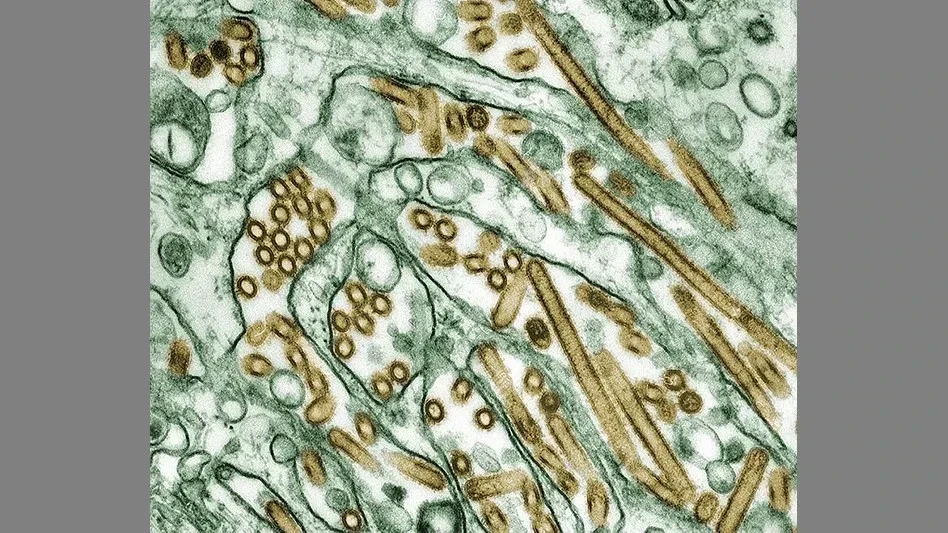The world is changing rapidly. In the “old days” you could only buy strawberries when they were in season. Today, you can buy them all year long because they are imported from around the world. Not too long ago, you had to buy a head of lettuce, tomatoes and mushrooms and clean, peel and chop them at home to make a fresh salad. Today, we can buy bagged salad that is already cleaned, chopped and assembled.
Unfortunately, as the ease and availability of foods improves, food safety and food defense concerns increase. In 2008, Americans are more aware than ever before of the impact that a contaminated food supply would have on public health.
In response to public concern, the U.S. Food and Drug Administration (FDA) recently developed the Food Protection Plan to integrate food safety and food defense strategies to protect our food supply. Food safety is the prevention of unintentional food contamination by developing and implementing prerequisite programs and monitoring finished products to ensure that safe and wholesome products reach consumers. Food defense is the prevention of intentional acts of food contamination by developing and implementing programs that reduce or eliminate identified risks.
In the plan, Michael Leavitt, Secretary of Health and Human Services, writes, “Americans enjoy unprecedented choice and convenience in filling the cupboard today, but we also face new challenges to ensuring that our food is safe. The Food Protection Plan will implement a strategy of prevention, intervention and response to build safety into every step of the food supply chain.”
Many societal changes have impacted the way we view our food supply. There are six core changes that prompted FDA to reevaluate the impact of food safety and food defense issues on the American marketplace.
1. DEMOGRAPHICS. As the baby boomer generation ages, more Americans are retiring. This increase, in addition to other groups with special needs (e.g., infants, pregnant women, and immuno-compromised people) is causing a shift in the number of people who are more susceptible to food-borne illnesses.
2. CONVENIENCE. Americans are consuming convenience foods, ready-to-eat foods and food service items, and are dining out and buying prepared foods in larger quantities. Foods prepared outside the home are subject to cross-contamination from food workers and other foods. These products are widely distributed, so food-borne illness is more widespread and affects greater numbers of people.
3. CONSUMPTION. Imported foods, including fruits and vegetables are available year round. Americans are encouraged to eat more produce and many of these foods are consumed raw or with minimal processing. There are more grocery and exotic items available with food safety hazards that may be unknown or misunderstood.
4. GLOBAL FOOD SUPPLY. According to USDA, the U.S. trades with more than 150 countries into more than 300 domestic ports. In the last 10 years, food imports into the U.S. have tripled in number, making seafood, vegetables, exotic foods and tropical fruits more readily available in the supermarket. In the past, most U.S. imports were unprocessed foods that were subject to further processing when they arrived. Today’s imports include more ready-to-eat foods and products that can be consumed with little or no further processing.
5. FOOD-BORNE PATHOGENS. Since the 1970s, new food-borne pathogens have emerged, requiring the development of advanced technologies to identify and detect these new pathogens. Fourteen newly identified pathogens associated with food-borne illnesses have been identified since the ’70s and that number continues to grow.
6. INTERNATIONAL CONTAMINATION. The recent recall of pet food contaminated with melamine illustrates the impact of intentional food contamination. Though not an act of terrorism, the addition of melamine for economic gain caused illness and death in many pets and the recall of hundreds of brands of pet foods, as well as quarantines and holds of livestock that had consumed the suspect feed. Because of these changes, a need to evaluate intentional and unintentional contamination risks to the food supply chain emerged.
CORE ELEMENTS OF THE FOOD PROTECTION PLAN. The three core elements of the Food Protection Plan are prevention, intervention, and response.
- Prevention: The prevention element includes promoting increased corporate responsibility so that food problems do not occur in the first place. By comprehensively reviewing food supply vulnerabilities and developing risk reduction measures with industry and other stakeholders, FDA can best address critical weaknesses.
- Intervention: The intervention element focuses on risk-based inspections, sampling and surveillance at high-risk points in the food supply chain. These interventions must verify that preventive measures are being implemented correctly.
- Response: The response element strengthens FDA’s emergency response efforts by allowing for increased speed and efficiency. It also includes the idea of better communication with other federal, state and local government agencies and industry during and after emergencies. Whether contamination is unintentional or deliberate, there is a need to respond quickly and to communicate clearly with consumers and other stakeholders. The communication should emphasize identifying products of concern as well as assuring the public of what is safe to consume.
Prevention is the primary focus of the three-pronged plan. The intent of the program is to identify and build in safety measures that address risks from the time a product is produced until it is consumed. The scope of the plan is applied to food for people and animals, domestic and imported products, and will encompass food safety and food defense tactics to accomplish this.
HOW WILL THIS BE ACCOMPLISHED? The Food Protection Plan identifies four ways to accomplish its goals.
- Focus on risks during the product’s life cycle from production to consumption
- Target resources to achieve maximum risk reduction
- Address intentional and unintentional contamination
- Use science and modern technology systems
These cross-cutting principles relate to the integrated plant by preventing food-borne illnesses, intervening with risk-based FDA actions at critical points in the food supply chain and responding rapidly when contaminated food or feed is detected.
Prevention steps include increasing corporate responsibility to prevent food-borne illness by identifying food vulnerabilities and assessing the risks. Risks are assessed throughout the food supply chain, from production to consumption, and include domestic and imported products. FDA’s vision is that corporations evaluate food safety and food defense vulnerabilities and their possible impacts, by establishing and implementing preventive measures to ensure that food is produced safely and securely and by developing a contingency plan to respond efficiently in the event of contamination.
Intervention steps focus on inspections and sampling based on risk, enhancement of risk-based surveillance and improving what FDA identifies as food system “signals” that indicate contamination. This is accomplished by developing a robust risk analysis program to identify and conduct high-priority inspections that rely on statistical sampling and risk detection tools. FDA will be looking for analysis of test results, adverse event reports, consumer complaints and other information to help track emerging food protection problems. FDA is considering certifying qualified third parties to assist with this program. This will include looking at expanding the use of rapid contamination detection technology, using more advanced screening technologies at the border, and strengthening the “Prior Notice of Imported Foods” (Bioterrorism Act) final rule in 2008 to allow FDA to do more risk-based inspection of imported foods. The agency also is looking at moving product inspections upstream by entering into agreements with the exporting countries’ regulatory authorities or by using FDA-recognized third parties to certify compliance prior to shipment.
Improving the detection of food system signals that indicate contamination requires the development of screening tools and methods to identify pathogens and to improve FDA’s adverse event and consumer complaint reporting system, including capturing complaints made to food manufacturers and distributors. FDA plans on creating two registries for reporting this information. The Reportable Food Registry will allow reports that signal a “reasonable probability that the use of or exposure to an article of food will cause serious harm or death to humans or animals.” Under the 2007 Food and Drug Administration Amendments Act (FDAAA), industry will be expected to report these within 24 hours. The Early Warning Surveillance and Notification System will be created to identify adulterated pet food products, outbreaks of pet illness and to notify veterinarians and other stakeholders during pet food recalls. Reporting of these incidences would fall under FDAAA.
Response goals are to provide immediate response to identify issues and to improve risk communication to the public, industry and other stakeholders that are part of this process. FDA is looking to allow itself to issue mandatory recalls of food products when voluntary recalls are not effective. In addition, FDA is looking to increase its authority to allow access to records that are necessary to identify the source of food-borne illness and take needed action. Currently, access is limited to instances where FDA has a reasonable belief that food is adulterated and presents a threat of serious adverse health consequences or death. FDA wants to expand that to include records of related articles of food, such as food produced on the same manufacturing line. The records would only apply to food safety or security. To ensure the effectiveness of the voluntary recall process, robust recall and traceability programs to identify sources of raw materials and track product distribution through individual products sold at convenience stores should be considered.
CONCLUSION. Changes to demographics, sourcing of food products and food consumption and the introduction of new food-borne pathogens and intentional contamination threats have created the need for a review of current food safety and food defense practices. FDA’s Food Protection Plan addresses the need to evaluate intentional and unintentional food contamination. By using science and risk-based assessment approaches, FDA hopes to better manage resources to prevent, intervene and respond to issues via effective partnerships with food manufacturers and other stakeholders.
The author is Director of Product Development, AIB International.
Latest from Quality Assurance & Food Safety
- IFT Virtual Workshop on Food Fraud Prevention to Address Supply Chain Disruptions
- Penn State Course Covers Fundamentals of Food Science
- Joint FAO/WHO Expert Committee on Food Additives Seeks Experts
- FDA Reschedules Webinar on Updated ‘Healthy’ Claim
- Thousands More Laid Off at FDA, CDC in HHS Restructuring
- USDA Extends Deadline on Request for Information for Poultry Quality Standards
- Dessert Holdings Issues Allergy Alert on Undeclared Pecans in Favorite Day Cheesecake
- Idaho Smokehouse Partners Recalls Beef Sticks Due to Possible Foreign Matter Contamination







